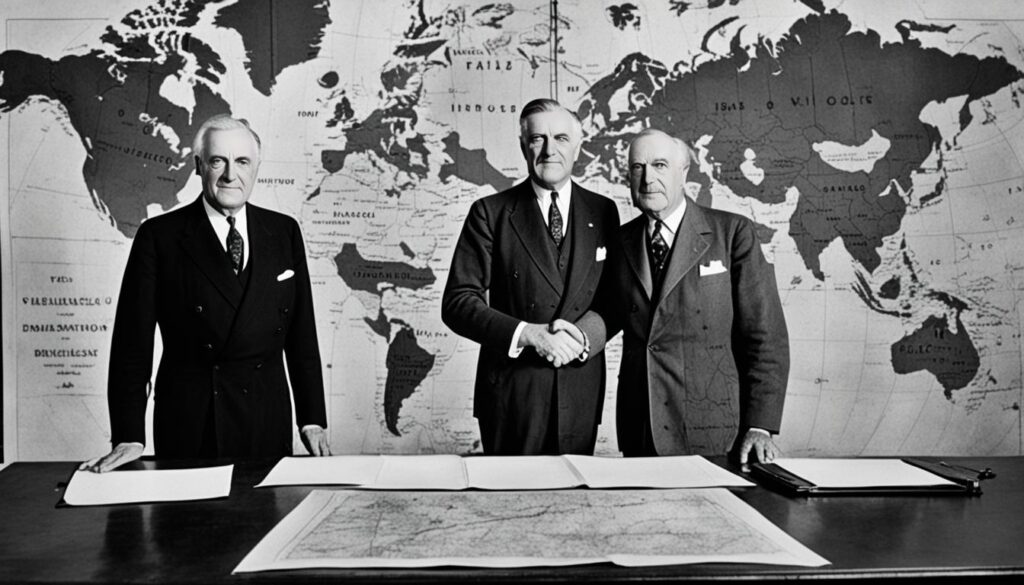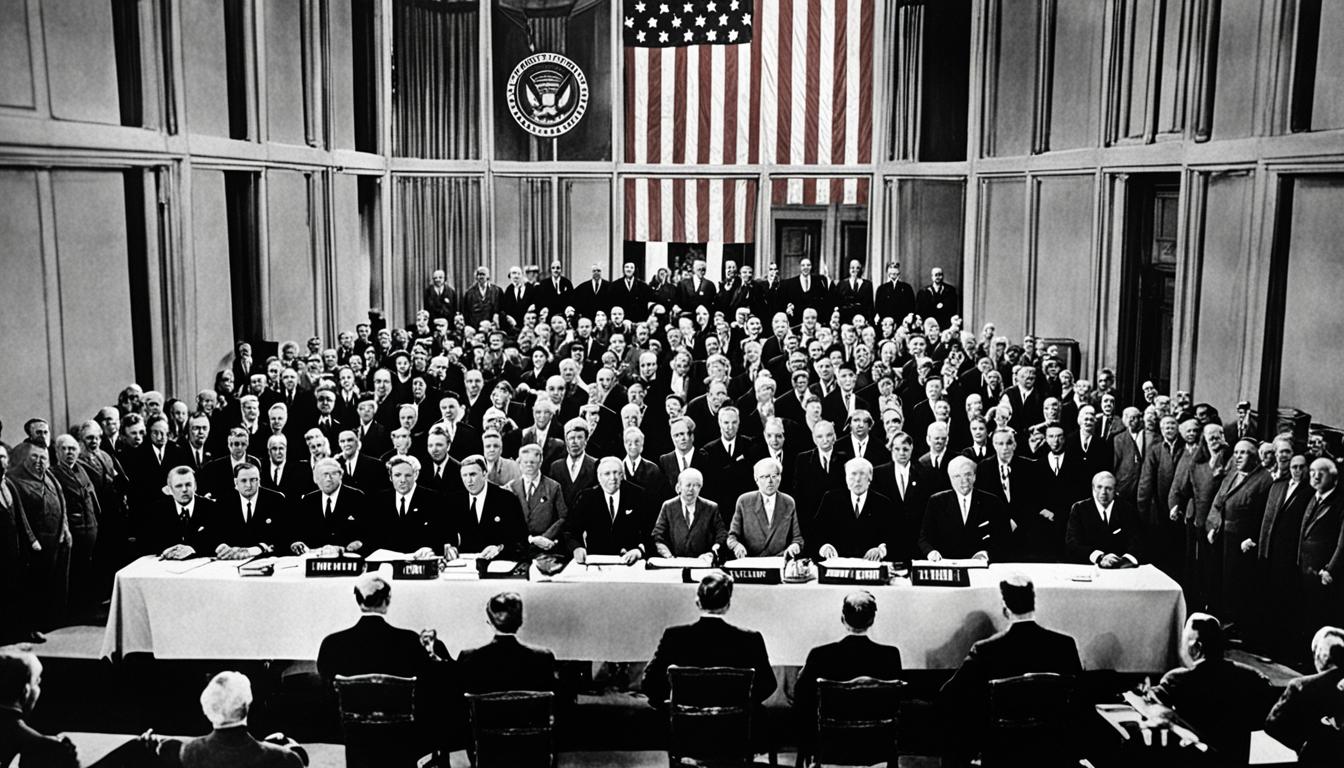In the aftermath of World War I, a groundbreaking international agreement known as the Kellogg-Briand Pact aimed to prevent conflicts and promote global peace. Initially signed by 15 nations on August 27, 1928, the pact, also referred to as the Pact of Paris, sought to outlaw war as an instrument of national policy. This Post-WWI War Outlawing Agreement garnered support from an additional 47 countries, bringing the total number of signatories to 62.
The Kellogg-Briand Pact represented a significant step towards international cooperation and peacekeeping efforts in the post-war era. By calling upon signatories to settle disputes through peaceful means, the pact aimed to prevent the outbreak of another devastating global conflict. The agreement was a testament to the world’s collective desire for lasting peace and stability following the horrors of World War I.
Key Takeaways
- The Kellogg-Briand Pact, signed in 1928, aimed to outlaw war and promote global peace.
- Initially signed by 15 nations, the pact eventually garnered support from a total of 62 countries.
- The agreement sought to prevent conflicts by encouraging signatories to settle disputes peacefully.
- The pact represented a significant step towards international cooperation and peacekeeping efforts post-WWI.
- The Kellogg-Briand Pact demonstrated the world’s collective desire for lasting peace and stability.
The Kellogg-Briand Pact: An Ambitious Attempt at Peacekeeping
In the aftermath of World War I, the Kellogg-Briand Pact emerged as one of the most ambitious attempts at deterring future conflict and promoting peacekeeping measures in international relations. The devastating impact of the war had left an indelible mark on the global consciousness, and public opinion strongly favored peace. As a result, peacekeeping initiatives took center stage in political agendas worldwide.
The “Paris Pact,” as it was also known, required its signatories to renounce war as a tool of national policy and commit to settling disputes through peaceful solutions. The pact’s architects believed that by outlawing acts of aggression, nations would be compelled to seek diplomatic means to resolve their differences, thereby reducing the likelihood of another catastrophic global conflict.
The response to the Kellogg-Briand Pact was overwhelming, with numerous nations eagerly signing on to demonstrate their commitment to maintaining peace. The widespread support for the pact reflected the collective desire to prevent a repeat of the horrors experienced during World War I. However, the pact’s effectiveness was ultimately undermined by a crucial provision that allowed for self-defense, which some nations exploited to justify acts of aggression.
Despite its eventual shortcomings, the Kellogg-Briand Pact remains a significant milestone in the history of international relations and peacekeeping measures. It represented a genuine attempt to renounce war and promote peaceful solutions to global conflicts, setting the stage for future efforts to establish a more stable and harmonious world order.
U.S. and French Leadership in Crafting the Pact
The Kellogg-Briand Pact, a groundbreaking international agreement aimed at outlawing war, was named after two key figures: U.S. Secretary of State Frank B. Kellogg and French Minister of Foreign Affairs Aristide Briand. These two statesmen played crucial roles in the pact’s creation and promotion, leading to its eventual adoption by over 60 nations.
Initially, Aristide Briand proposed a bilateral agreement between France and the United States to deter aggression, particularly from Germany, which had been a source of concern for France in the aftermath of World War I. However, U.S. President Calvin Coolidge and Secretary of State Frank B. Kellogg saw an opportunity to expand the agreement’s scope and include other nations, thereby increasing its potential impact on global peace.

The idea of extending the pact to include other nations was well-received by the international community, as many countries were eager to prevent another devastating war. U.S. diplomat William Richards Castle Jr. played a key role in this process, working tirelessly to overcome French objections and replace the narrow Franco-American agreement with a multinational treaty that would have a broader impact on international relations.
Through the combined efforts of Frank B. Kellogg, Aristide Briand, and other dedicated diplomats, the Kellogg-Briand Pact evolved from a bilateral agreement between two nations into a comprehensive international treaty that renounced war as an instrument of national policy. This transformation was a testament to the leadership and vision of the individuals involved, who recognized the importance of collective action in the pursuit of global peace and stability.
Legacy and Impact of the Kellogg-Briand Pact
Despite its noble intentions, the Kellogg-Briand Pact failed to prevent the outbreak of World War II or any of the subsequent conflicts that followed. The pact lacked real legal consequences for violations, and nations began justifying their international aggression as acts of self-defense. However, the pact’s legacy remains as a statement of the idealism expressed by advocates for peace in the interwar period.
Frank Kellogg, the U.S. Secretary of State who played a crucial role in crafting the pact, was awarded the Nobel Peace Prize in 1929 for his efforts. The key ideas from the pact, such as renouncing war and promoting peaceful solutions to international disputes, were later incorporated into the United Nations Charter in 1945. This charter aimed to establish a more effective system of collective security and international law to prevent future conflicts.
Interestingly, the Kellogg-Briand Pact served as the legal basis for the concept of a crime against peace, for which German and Japanese leaders were tried and executed as war criminals after World War II. This concept of holding individuals accountable for initiating wars of aggression was a significant development in international law. In a similar vein, the establishment of the Washington-Moscow hotline during the Cold War aimed to facilitate direct communication between the U.S. and the Soviet Union, preventing misunderstandings that could lead to nuclear war.

Leave a Reply